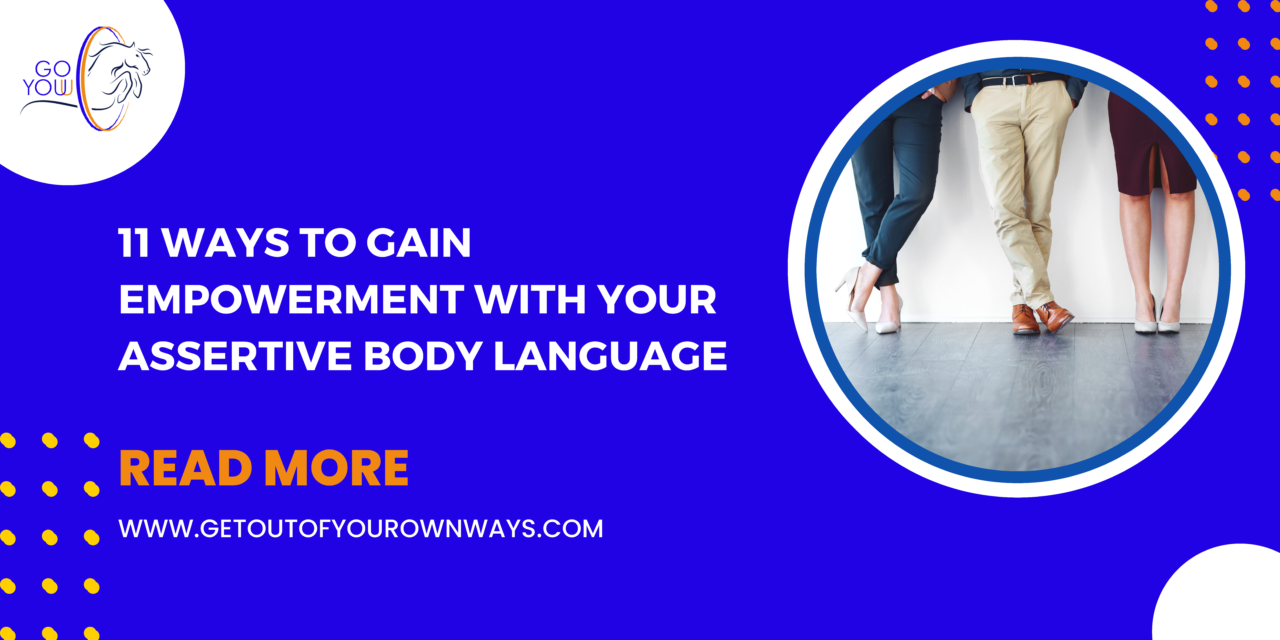Are you aware of how your presence and body language shows up when you are around other people and in various situations? Are you oozing positive empowered energy? Is your body language demonstrating calm, confident and collected presence? Or are you leaking negative insecure vibes with body language that appears sheepish, unsure and unremarkable? Here,Gain Empowerment With Your Assertive Body Language
When you have an assertive presence and body language, you convey confidence, self-assurance, and a sense of purpose. This can make others take you more seriously, respect you, and listen to what you have to say. By becoming more aware of your body language, you can communicate more effectively and build stronger relationships with those around you.
Here are 11 Ways for Becoming More Aware and Assertive with your Body Language:
1. Become More Aware of Your Body Language
Self-awareness is key to being in control of yourself and not living life on auto-pilot. Learning how you present to others is empowering. It’s important to be aware of your body language and what it may be communicating to others. For example, crossing your arms can be perceived as defensive or closed off, while leaning forward can show interest and engagement.
2. Eye Contact
Maintaining eye contact during a conversation signals confidence and attentiveness. It shows that you are fully engaged in the conversation and not easily intimidated. Yes. Maintaining eye contact shows that you are engaged, however, it’s important to strike a balance. Too little eye contact can make you seem disinterested, while too much can be intimidating.
3. Pay Attention to Your Posture
Notice how you stand or sit when you’re speaking with others. Are you slouching or standing up straight? Try to adopt a confident and upright posture, which can convey assertiveness and self-assurance. Slouching or hunching over can make you appear insecure or unsure of yourself. Standing up straight with your shoulders back and your head held high can convey confidence and assertiveness.
4. Observe Your Gestures
Take note of the gestures you use when you’re speaking. Do you use your hands to emphasise your points or to fidget nervously? Be mindful of your gestures and try to use them purposefully to enhance your communication. Using deliberate and controlled hand gestures can emphasise important points and help you appear more confident and engaged. However, excessive or nervous gestures can be distracting and undermine your credibility.
5. Watch Your Facial Expressions
Your facial expressions can convey a lot about your emotions and attitudes. Are you smiling or frowning? Are your eyebrows raised or furrowed? Try to be aware of your facial expressions and adjust them accordingly to match the tone of your message. Use facial expressions to convey warmth and openness. Smiling can help to establish a friendly rapport with others, while frowning or scowling can be seen as hostile or confrontational.
6. Listen to Your Tone of Voice
Your tone of voice can also communicate a lot about your emotions and intentions. Are you speaking in a calm and measured tone, or are you speaking rapidly and anxiously? Be mindful of your tone of voice and adjust it to match the message you want to convey. Speaking in a clear and confident voice can convey authority and conviction. Avoid speaking too quickly or quietly, as this can make you appear uncertain or unprepared. Speaking in a clear, confident voice is essential to assertive communication.
7. Get Feedback from Others
Ask friends, family, or colleagues to give you feedback on your body language. They may notice things about your posture, gestures, or expressions that you’re not aware of, and their feedback can help you become more conscious of your own body language. It might feel uncomfortable to ask them however the benefits of this knowledge far outweigh that feeling.
8. Take a Pause
It is perfectly fine to take a pause as you are speaking. Get comfortable with short silences. This ensures that others can process your information and they understand that you are in control of the pace.
9. Take Up Space
Assertive people tend to take up space – both physically and verbally. This means speaking up and taking your fair share of the conversation, as well as using confident body language to convey your presence. Take up the full space of your chair, use the table also to take your space with your notebook and / or hands.
10. Record Yourself
Record yourself and see any movements and habits that you may have been unaware of and that you might want to change, adapt or enhance. It may feel scary to record yourself however it will give you a wealth of information and as we know information is power. Press record!
11. Practice Assertiveness
Like any skill, assertiveness can be developed through practice. Start by practicing assertive communication in low-stakes situations, and gradually work your way up to more challenging interactions. For example, engage with the shop assistant, the bus driver, and with trusted family and friends.
Overall, assertive presence and body language are important for establishing credibility and projecting confidence in both personal and professional settings. By paying attention to these nonverbal cues, you can improve your communication skills and build stronger relationships with others. Working with a friend or life coach can help you along this assertiveness journey so why not reach out.

